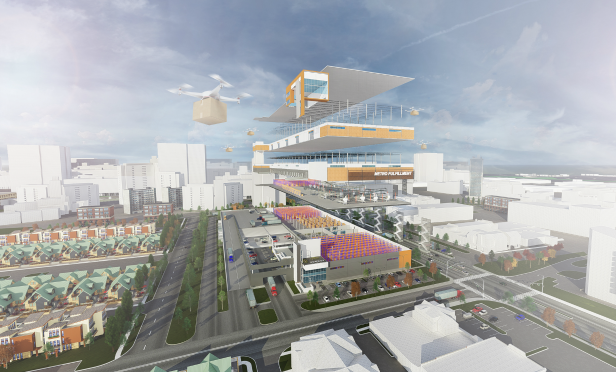Multi-story industrial has been a kind of abstract idea as a solution to the growing supply constraints and industrial needs in Southern California—but it is likely closer than you think to becoming a reality. Designer Ware Malcomb has created a multi-story industrial design prototype in response to increasing demands from developers. The firm says that this model is the future of urban industrial, and it meets the unique needs of ecommerce and last-mile delivery companies.
The firm approached the design prototype with three fundamental rules in mind. First, the building layout cannot compromise tenant functionality, including truck yards and doors, racking, aisles and clear heights, for example. Next, the building structure and systems must be designed to keep the cost as low as possible. Finally, the building must be designed for complete flexibility with the option to be leased as a typical multi-tenant building. “Based on the high volume of inquiries we are receiving, and the multistory site plans our team is processing daily, the interest and demand are consistently increasing,” according to Jay Todisco, EVP at Ware Malcomb, tells GlobeSt.com. “We are currently in final design and engineering on five multi-story distribution projects that will be built in North America.”
Multi-story industrial seems like the perfect solution to the supply challenges in Southern California, but the model typically comes with higher costs than a standard, single-story industrial building. “To understand the costs, we had full architectural and engineering drawings priced in detail by general contractors,” explains Todisco. As a result, functionality and cost are the biggest challenges in designing a prototype that will work. “The multistory distribution buildings cannot compromise functionality and must be as economical to build as possible,” says Todisco. “The biggest challenge will be for capital markets to recognize, and ultimately embrace multistory facilities as institutional grade real estate assets. This will not happen until a few facilities are fully built and the leasing absorption can be measured and normalized with buildings of similar usage.”
The firm took a close look at the cost challenge during the design, and found that it is possible to make these projects pencil, considering rapidly rising demand and rental rates. “We evaluated several alternate structural systems and building skins, with careful attention to constructability in urban locations with limited site access and staging. The multistory distribution buildings cost three times as much as a comparable building, but the net result is at least two times more rentable area. Demand will continue to increase for the next several decades due to the explosion of last touch delivery expectations, and growing e-commerce consumer demand.”
Europe has used multi-story industrial facilities for years, and the concept is already being put into practice on the East Coast. Ware Malcomb is currently under construction on a three-story ecommerce distribution center totaling approximately 375,000 square feet in Red Hook, Brooklyn. It will be the first multi-story industrial project to open in the market. “We have been working with different developers and have several projects that are scheduled for construction completion within the next 18 months,” adds Todisco. “Multistory distribution projects tend to be in highly urbanized locations with dense population profiles and adjacent to international sea ports. The common denominators of these locations are high land cost and growing e-commerce last touch consumer demand.”
© Touchpoint Markets, All Rights Reserved. Request academic re-use from www.copyright.com. All other uses, submit a request to [email protected]. For more inforrmation visit Asset & Logo Licensing.







